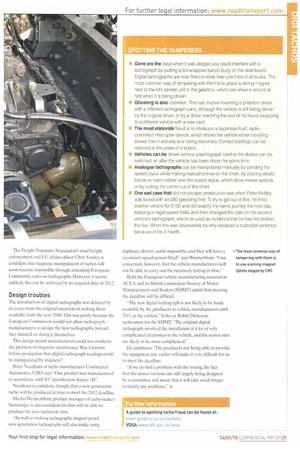Fiddler on the hoof
Page 26

Page 27

If you've noticed an error in this article please click here to report it so we can fix it.
Despite the fanfare, digital tachographs appear as prone to fiddling as their analogue predecessors. Will the new generation beat the fraudsters?
Words: Mike Sherrington Tachographs were first introduced in the 1920s for the railroad industry; they were adopted by the European road transport industry in 1985.
Since then, any number of unscrupulous drivers have attempted to subvert their purpose, which is to record legal driving hours. Similar to drug cheats in sport, as soon as the technology improves, the cheats seek a new way to get around it.
The difference with tachograph fraud, though, is that it leads to drivers working more hours than they arc allowed a knock-on effect of that is driver fatigue, which is a killer.
Around 300 road deaths a year are caused by drivers falling asleep at the wheel. One HGV driver killed a cyclist after driving 41 hours out of a previous 57 Of course, a custodial sentence cannot rectify the damage caused by such behaviour.
Penalties
Even if a driver is not involved in a fatal accident, the penalties for tachograph fraud can he severe, attracting a maximum fine of £5,000 and up to two years in prison. Yet despite these deterrents, road safety charity Brake estimates that around 100,000 commercial vehicles a year are guilty of paperwork fraud with the most common offence being the falsification of tachograph records.
Digital tachographs, which were introduced for all new vehicles from May 2006, are not immune from this type of fraud. In October, a Moldavian driver, Ivan Kayryak. was fined £200 by Rochdale Magistrates for placing a
powerful magnet on his digital gearbox sensor, which meant his tachograph showed him at rest when, in fact, he was driving (`Foreign driver fined for tacho falsification CM 15 October 2009).
In January, Hungarian driver Gabor Fuksz was given a 16-week jail sentence and a 15-month driving ban for committing a similar offence. Fuk.sz's felony was further compounded because he was stopped for driving at 80mph.
"Fitting a magnet not only knocks out the tacho and speed limiter, but it can also mean the speedometer doesn't work," reveals Karen Crispe. director of Warrington-based Tachodisc, "Quite often, drivers found guilty of tacho offences are first stopped for speeding."
Last year, VOSA prosecuted 141 people for tacho offences, and there is the likelihood that the present economic climate will force even more to breach drivers' hours rules by fiddling their tachographs.
Reasons for interference -Mere are three reasons why tachographs are interfered with," says Road Haulage Association head of training Steve Ellis, "It can be driven by employers in order to make jobs more profitable, or by drivers worried about hanging on to employment.
"A driver may need to get home for personal reasons, and is not prepared to have an overnight stop. However, it is logical to suspect that, in a very difficult time for the industry, the number of offences will increase."
The Freight Transport Association's road freight, enforcement and EU affairs officer Chris Yarsley is confident that magnetic manipulation of tachos will soon become impossible through amending European Community rules on tachographs. However, it seems unlikely this can he achieved by its targeted date of 2012.
Design troubles
The introduction of digital tachographs was delayed by six years from the original intention of making them available from the year 2000. This was partly because the European Commission would not allow tachograph manufacturers to design the new tachographs, instead, they insisted on doing it themselves.
This design meant manufacturers could not eradicate the problem of magnetic interference. Was it known before production that digital tachograph readings could be manipulated by magnets?
Peter Needham of tacho manufacturer Continental Automotive VDO says: "Our product was manufactured in accordance with EC specification Annex 1137 Needham is confident, though, that a new-generation tacho will be produced in time to meet the 2012 deadline.
Martin Wennerblom, product manager of tacho-maker Stone ridge. is also conlident his firm will be able to produce the new tachos on time.
"As well as making tachographs magnet-proof, new-generation tachographs will also make using duplicate drivers' cards impossible: and they will have a secondary speed sensor fitted," says Wennerblom."I am concerned, however, that the vehicle manufacturers will not be able to carry out the necessary testing in time."
Both the European vehicle manufacturing association ACEA and its British counterpart Society of Motor Manufacturers and Traders (SMMT) admit that meeting the deadline will be difficult.
"The new digital tachograph is not likely to he made available by the producers to vehicle manufacturers until 2011 at the earliest," believes Robin Dickeson, spokesman for the SMMT. "The original digital tachograph involved the installation of a lot of very complicated electronics in the vehicle, and the newer ones are likely to be more complicated."
He continues: ''The producers not being able to provide the equipment any earlier will make it very difficult for us to meet the deadline.
"If we do find a problem with the testing, the fact that the newer versions are still largely being designed by a committee will mean that it will take much longer to rectify any problems" * Further information: A guide to spotting tacho fraud can be found at: www.greatrtx.co.uk/lec6doc VOSA: www.dft.gov.uk/vosa




































































































































